Crafting a spear with a rock is an exciting and resourceful skill, blending natural elements with ingenuity. Rockscapes.net provides a comprehensive guide to crafting your own spear using rocks, perfect for DIY enthusiasts and those interested in primitive skills. Rock spear creation involves selecting the right materials, shaping them effectively, and ensuring a secure assembly for functionality and safety.
1. What is a Rock Spear and Why Make One?
A rock spear is a primitive tool crafted by attaching a sharpened rock point to a wooden shaft, historically used for hunting and defense. There are many reasons that people want to create a rock spear including:
- Survival Skills: Making a rock spear teaches valuable survival skills, allowing you to create a hunting tool from natural materials.
- Historical Connection: Crafting a rock spear connects you to ancient human history and the resourcefulness of our ancestors.
- Outdoor Activity: It’s a fun and engaging outdoor activity that encourages exploration and creativity.
- Self-Reliance: Knowing how to make a rock spear fosters self-reliance and preparedness in wilderness situations.
- Appreciation for Nature: The process enhances your appreciation for nature and the resources it provides.
- Cost-Effective: Crafting your own spear can be a cost-effective alternative to purchasing manufactured hunting tools.
- Customization: You can customize the spear’s design and materials to suit your specific needs and preferences.
2. What Kind of Stone Do I Need?
The ideal stone for a spearhead is one that is hard, brittle, and can be easily shaped. According to research from Arizona State University’s School of Earth and Space Exploration, flint and obsidian are among the best choices due to their conchoidal fracture, which allows for the creation of sharp edges.
2.1 Types of Stones Ideal for Spear Points
| Stone | Characteristics | Advantages | Disadvantages |
|---|---|---|---|
| Flint | Fine-grained, sedimentary cryptocrystalline form of quartz. | Sharp edges, relatively easy to knap, widely available. | Can be brittle, requires skill to work with. |
| Obsidian | Volcanic glass with a smooth, uniform texture. | Extremely sharp edges, easy to flake, visually appealing. | Very brittle, can be difficult to control during knapping. |
| Chert | Sedimentary rock composed of microcrystalline or cryptocrystalline quartz. | Durable, holds an edge well, more forgiving than flint or obsidian. | Edges may not be as sharp as flint or obsidian. |
| Quartzite | Metamorphic rock composed primarily of quartz. | Very hard and durable, resistant to wear. | Difficult to knap, requires specialized tools and techniques. |
| Jasper | Opaque, microcrystalline variety of quartz. | Strong, can be shaped with reasonable effort, available in various colors. | May not produce edges as sharp as other options. |
| Basalt | Fine-grained volcanic rock. | Widely available, can be shaped into a functional point. | Does not hold an edge well, more suitable for rough spearheads. |
| Slate | Fine-grained, foliated metamorphic rock. | Can be easily shaped and split into thin pieces. | Not very durable, edges are not very sharp. |
| Sandstone | Sedimentary rock composed of sand-sized grains of mineral, rock, or organic material | Can be used in a pinch, relatively easy to find and shape. | Very soft, does not hold an edge at all, only suitable for very temporary or non-critical applications. |
2.2 Stone Availability in the U.S.
- Flint: Found in many areas, particularly in Texas, Ohio, and Tennessee.
- Obsidian: Common in volcanic regions such as Oregon, California, and Arizona.
- Chert: Widely distributed across the United States, often found in riverbeds and sedimentary deposits.
3. What Materials Do I Need to Make a Spear with a Rock?
To craft a spear using a rock, you’ll need a few essential materials. These components will ensure that your spear is both functional and safe to use.
- Arrowhead-Shaped Stone: Choose a stone that is naturally shaped like an arrowhead or can be easily knapped into one.
- Straight Stick: Select a sturdy, straight stick about 4-6 feet long for the spear shaft.
- Strong Cordage: You’ll need strong cordage such as twine, rope, or paracord to secure the stone to the shaft.
- Knife or Sharp Tool: A knife or sharp tool is necessary for shaping the wood and preparing the materials.
- Protective Gear: Wear gloves and eye protection to prevent injuries while working with sharp objects and stones.
3.1 Selecting the Right Wood for the Spear Shaft
| Type of Wood | Characteristics | Advantages | Disadvantages |
|---|---|---|---|
| Ash | Strong, flexible, and relatively lightweight. | Excellent shock resistance, easy to work with. | Can be susceptible to rot if not properly treated. |
| Hickory | Very strong, dense, and durable. | High impact resistance, long-lasting. | Heavy, can be difficult to shape. |
| Oak | Hard, strong, and resistant to decay. | Durable, holds up well in various weather conditions. | Heavy, can be challenging to split and shape. |
| Maple | Hard, dense, and relatively easy to work with. | Smooth finish, good strength for its weight. | Less resistant to rot compared to oak or hickory. |
| Birch | Lightweight, flexible, and readily available in many regions. | Easy to work with, good for smaller spears. | Not as strong as ash or oak, can be prone to bending or breaking under heavy stress. |
| Pine | Soft, lightweight, and easy to shape. | Readily available, good for practice spears. | Not very strong, prone to splintering, not suitable for hunting large game. |
| Willow | Flexible, lightweight, and grows quickly. | Easy to bend and shape, good for temporary or survival spears. | Not very durable, prone to rotting, limited strength. |
| Bamboo | Strong, lightweight, and naturally hollow. | Excellent strength-to-weight ratio, naturally straight. | Can be brittle if not properly treated, requires specific cutting and preparation techniques. |
| Hazel | Flexible, strong, and can be coppiced for sustainable harvesting. | Easy to work with, good for smaller spears and throwing spears. | Not as strong as ash or oak, requires regular maintenance. |
| Cedar | Lightweight, decay-resistant, and aromatic. | Naturally resistant to rot and insects, easy to work with. | Softer than other hardwoods, not ideal for heavy impact applications. |
3.2 Types of Cordage for Securing the Point
| Type of Cordage | Characteristics | Advantages | Disadvantages |
|---|---|---|---|
| Natural Fiber | Made from plant or animal fibers, such as hemp, cotton, or sinew. | Renewable, biodegradable, provides a traditional look and feel. | Less strong than synthetic options, prone to rotting if not properly treated, can stretch when wet. |
| Synthetic | Made from materials like nylon, polyester, or paracord. | Very strong, resistant to rot and mildew, holds its shape well. | Not biodegradable, can be slippery and difficult to grip in wet conditions, may melt if exposed to high heat. |
| Leather Strips | Made from tanned animal hide. | Strong, durable, provides a secure grip, can be aesthetically pleasing. | Can be expensive, requires maintenance to prevent drying and cracking, can be affected by moisture. |
| Braided Cord | Multiple strands woven together for increased strength and durability. | High tensile strength, resists abrasion, distributes load evenly. | Can be bulky, more difficult to tie knots with compared to single-strand cordage. |
| Twisted Cord | Multiple strands twisted together, offering a balance of strength and flexibility. | Relatively strong, easy to knot, more affordable than braided cord. | Less resistant to abrasion compared to braided cord, can unravel if not properly secured. |
| Sinew | Made from animal tendons, a traditional material used by indigenous cultures. | Very strong when dry, conforms well to the spear shaft and stone point. | Requires preparation and can be difficult to obtain, loses strength when wet. |
| Plant Fibers | Cordage made from plant fibers such as nettle, flax, or yucca. | Sustainable, renewable, lightweight, good for survival situations. | Less strong than other options, requires processing to extract and prepare the fibers. |
| Wire | Thin, flexible metal strand. | Extremely strong, durable, can be used for a very secure attachment. | Can be dangerous if it breaks, may cut into the wood or stone, not a traditional material. |
4. What are the Steps to Making a Spear with a Rock?
Making a spear with a rock can be accomplished through several methods. Here are two effective approaches:
4.1 Method One: Split Shaft Technique
- Prepare the Shaft: Cut the end of the stick so it’s flat.
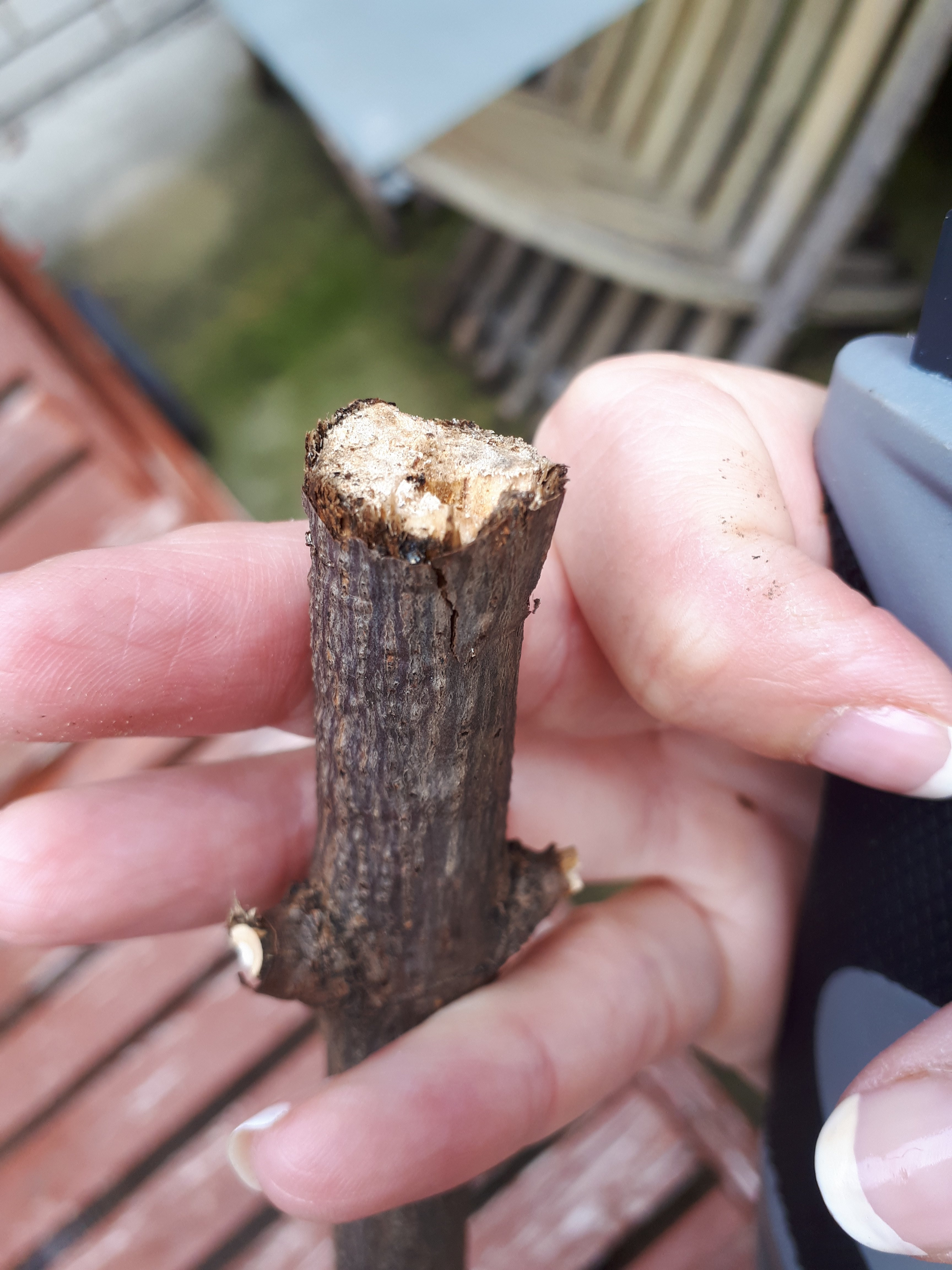 Cut the end of the stick flat for making a spear with a rock
Cut the end of the stick flat for making a spear with a rock - Create a Split: Cut the stick lengthwise, about two and a half inches from the top.
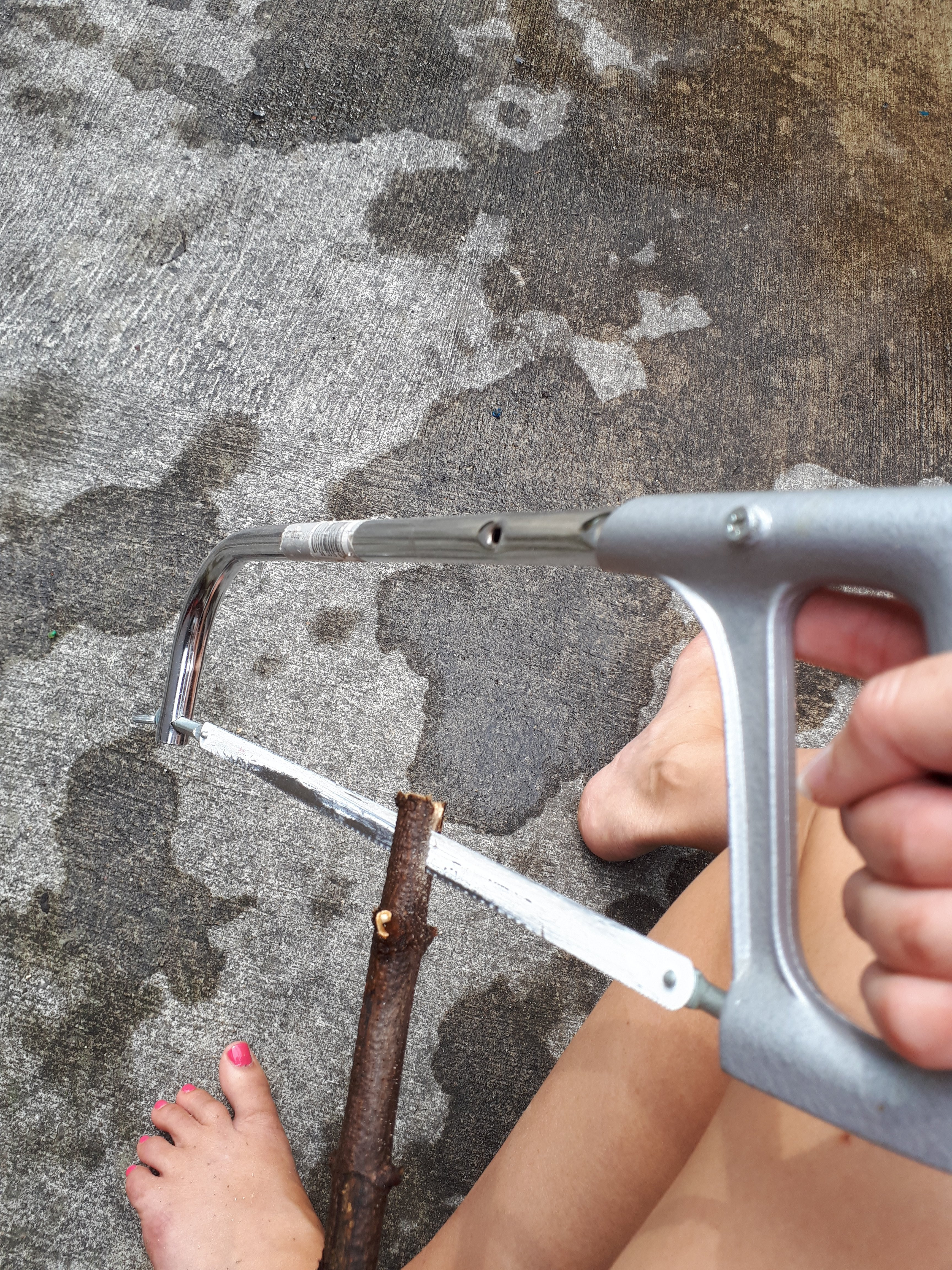 Cut the stick lengthwise for spear rock creation
Cut the stick lengthwise for spear rock creation - Insert Stone: Insert the stone into the gap, about halfway down the cut.
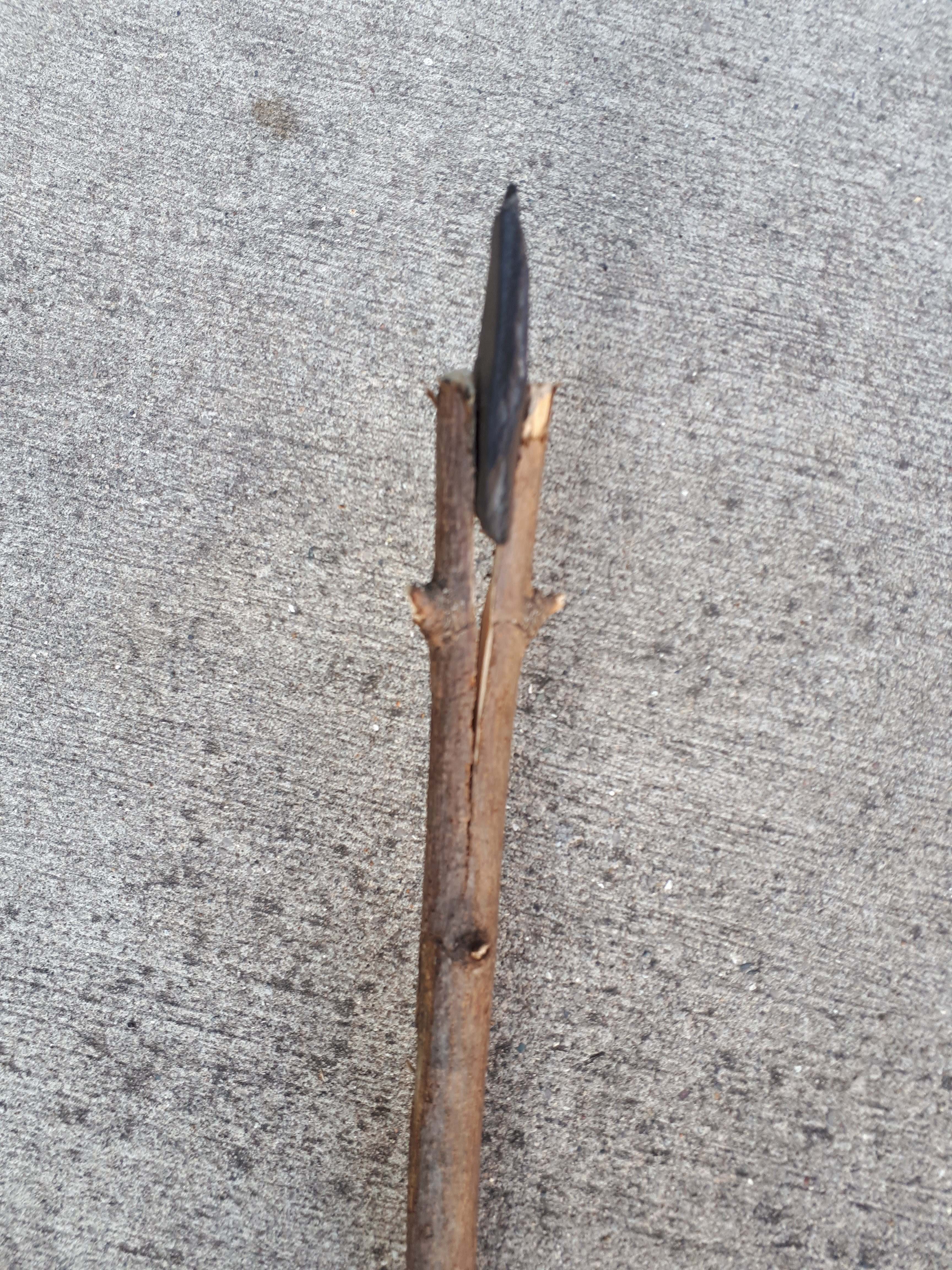 Insert stone into gap for rock spear making
Insert stone into gap for rock spear making - Secure with Cordage: Wrap the string tightly around the stick directly below the stone. Tie a knot or two to secure it.
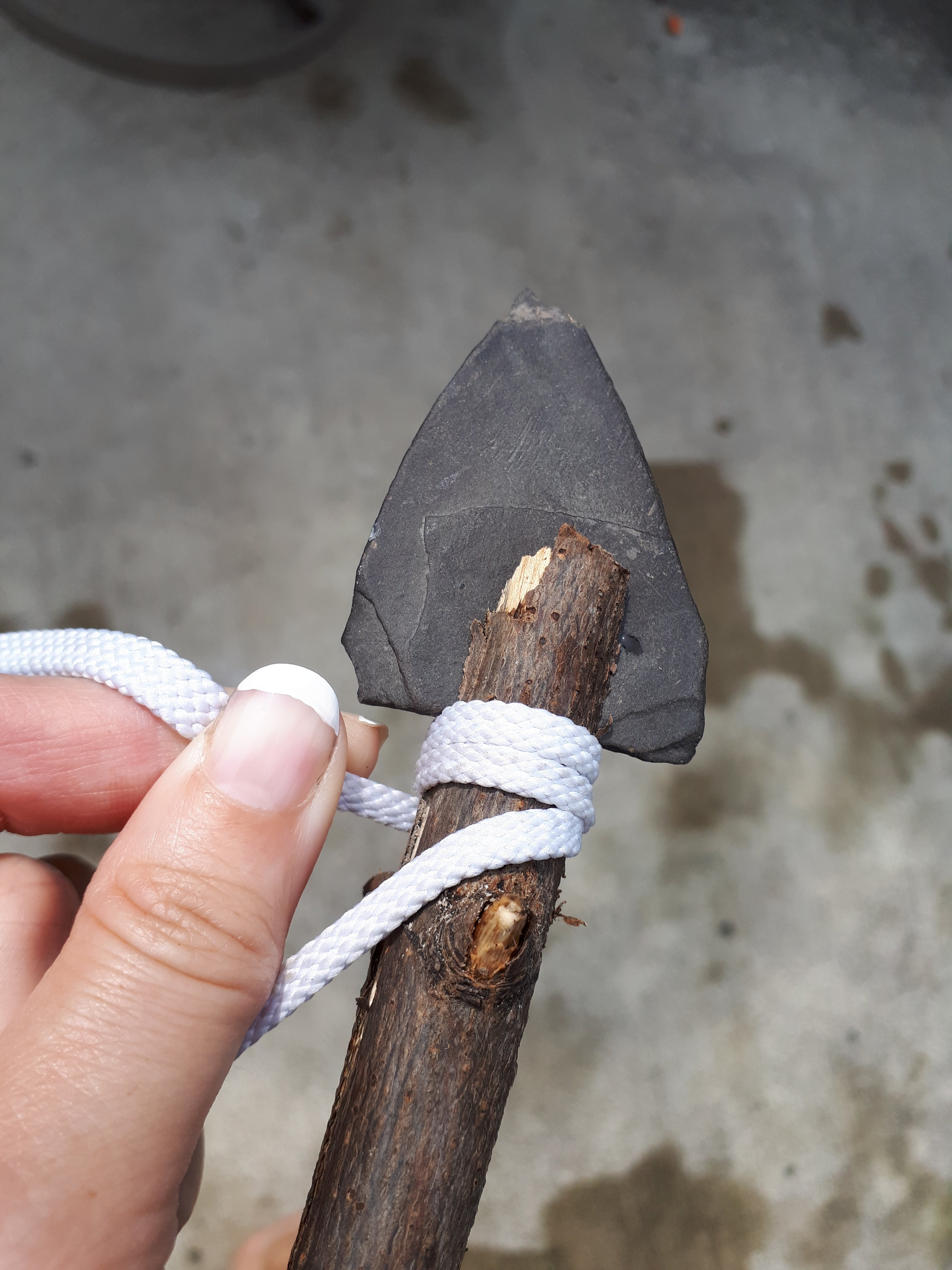 Secure the rock to the stick with cordage for making a rock spear
Secure the rock to the stick with cordage for making a rock spear
4.2 Method Two: Two-Stick Sandwich
- Gather Materials: Collect two flat sticks and an arrowhead-shaped stone.
- Position the Stone: Place the end of the stone in between the sticks.
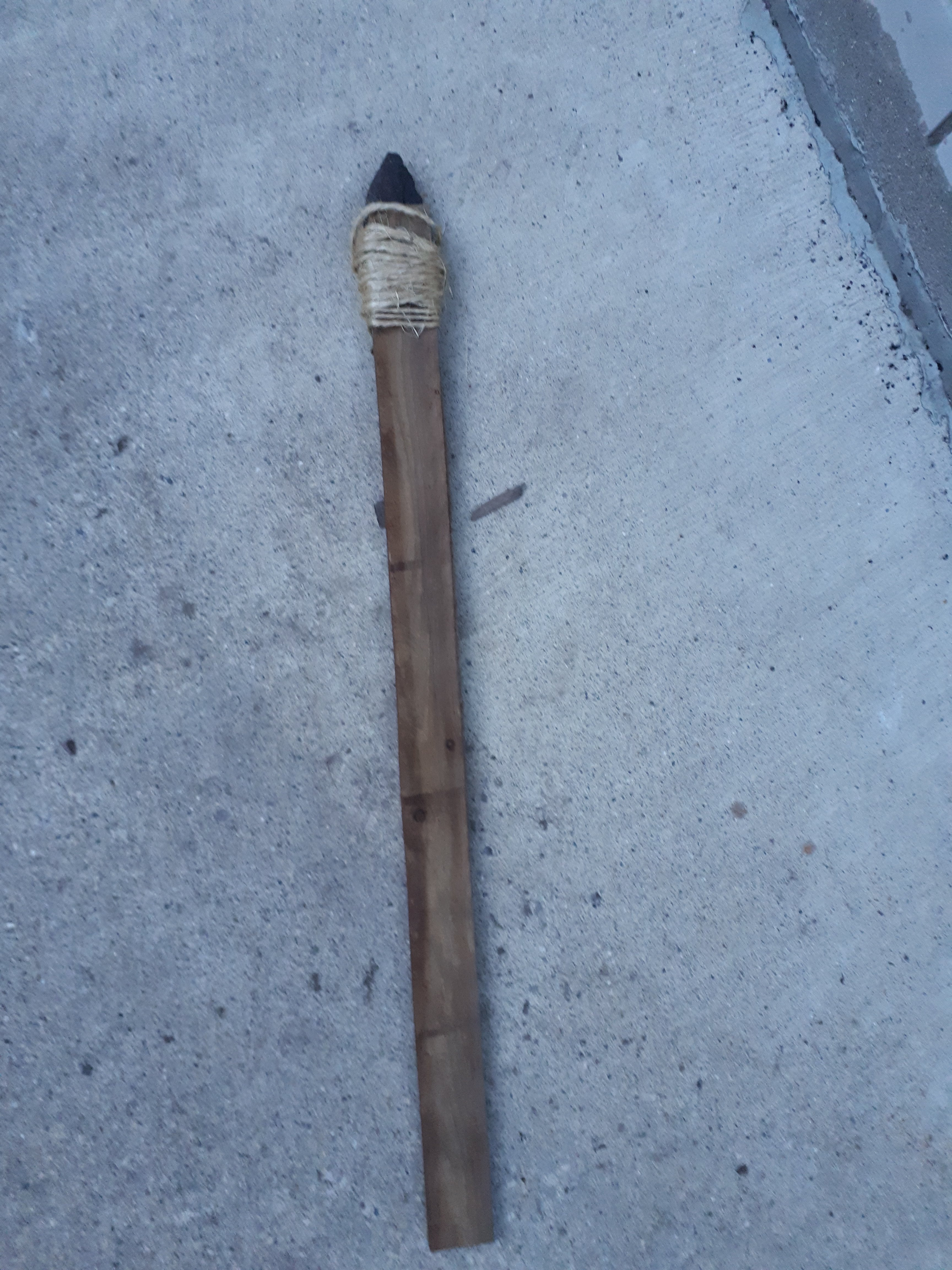 Position the stone between the sticks for rock spear building
Position the stone between the sticks for rock spear building - Secure the Sticks: Wrap rope around both ends of the stick, so hold the sticks together and to hold the stone in place.
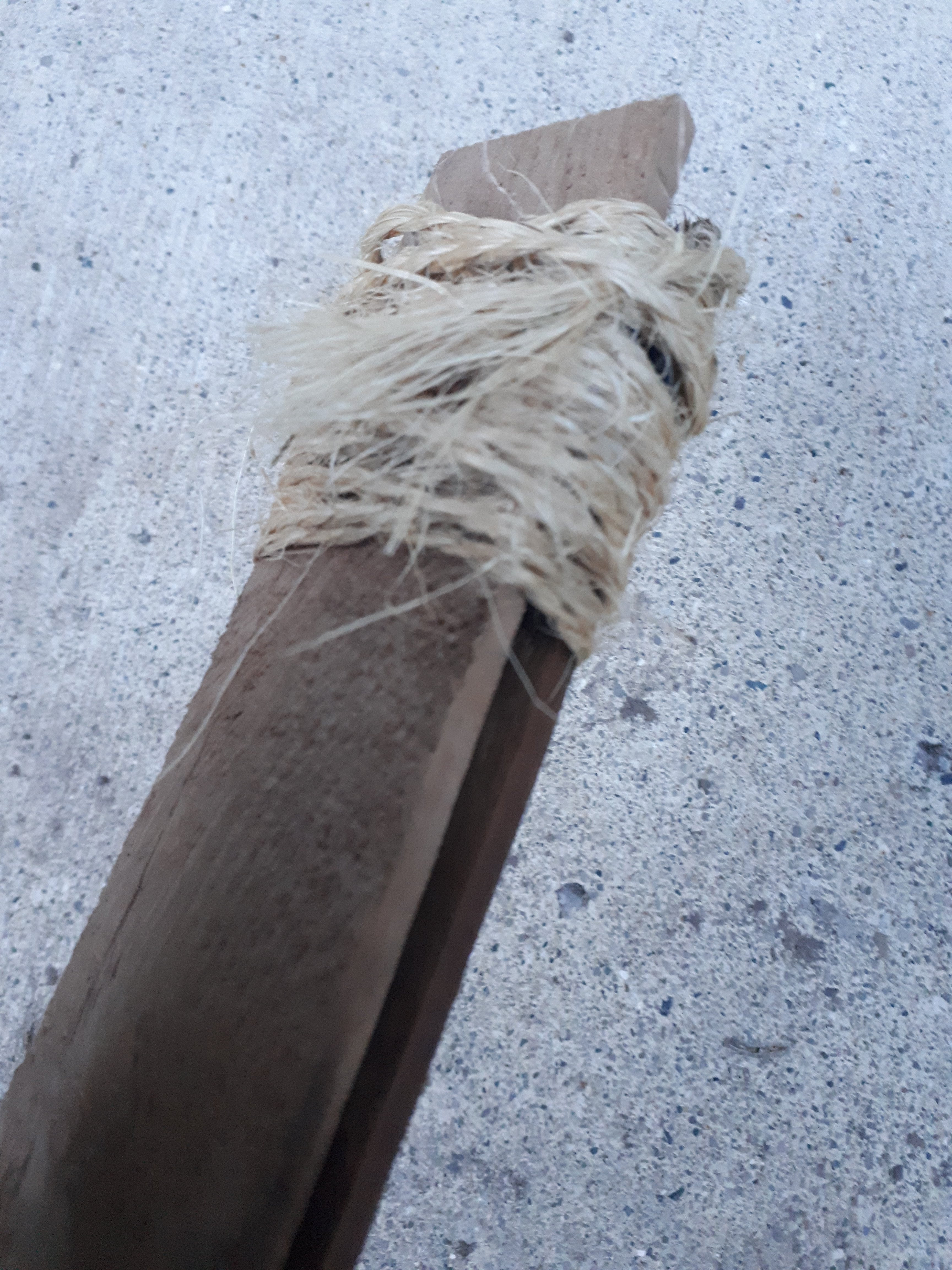 Wrap rope around both ends to hold the sticks together for spear rock making
Wrap rope around both ends to hold the sticks together for spear rock making
5. What are the Safety Measures to Consider When Building a Rock Spear?
When constructing a rock spear, safety should be a top priority. According to the National Safety Council, taking precautions can significantly reduce the risk of injuries associated with tool use.
5.1 Key Safety Tips
- Wear Protective Gear: Always wear safety glasses and gloves to protect your eyes and hands from sharp edges and splinters.
- Use Sharp Tools Carefully: Handle knives and other sharp tools with caution. Cut away from yourself and keep your fingers clear of the blade.
- Secure the Stone Properly: Ensure the stone is securely fastened to the shaft to prevent it from dislodging during use.
- Choose a Safe Work Area: Work in a well-lit area with a stable surface. Keep the area free from obstructions and distractions.
- Supervise Children: If children are involved in the process, provide close supervision and ensure they understand the importance of safety.
- Avoid Using Brittle Stones: Select stones that are less likely to shatter or break during the construction or use of the spear.
- Maintain Your Tools: Keep your tools sharp and in good working condition. Dull tools require more force and can be more dangerous.
- Be Aware of Your Surroundings: When testing or using the spear, be mindful of your surroundings and ensure there are no people or objects in the path of the spear.
- Store the Spear Safely: When not in use, store the spear in a safe place where it cannot be accidentally accessed or cause injury.
- Know Basic First Aid: Be prepared to handle minor cuts and scrapes. Keep a first aid kit nearby and know how to use it.
6. What are the Ethical Considerations for Rock Spear Use?
Using a rock spear, especially for hunting, involves ethical considerations that align with responsible and sustainable practices.
6.1 Responsible Hunting
- Legal Compliance: Always adhere to local hunting regulations and laws, including licensing, permitted game, and seasonal restrictions.
- Fair Chase: Practice fair chase principles, ensuring the animal has a reasonable chance of escaping. Avoid using the spear in ways that give you an unfair advantage.
- Respect for Wildlife: Treat animals with respect and avoid causing unnecessary suffering. Aim for a quick, clean kill to minimize pain.
6.2 Environmental Impact
- Sustainable Harvesting: Be mindful of the impact on local ecosystems. Avoid over-harvesting resources and ensure that your activities do not harm the environment.
- Leave No Trace: Practice the Leave No Trace principles. Pack out everything you pack in and minimize your impact on the land.
- Habitat Preservation: Be aware of the habitats of local wildlife and take steps to protect them. Avoid disturbing sensitive areas and respect wildlife corridors.
6.3 Cultural Sensitivity
- Respect for Indigenous Practices: Be respectful of traditional hunting practices and cultural sites. Avoid appropriating cultural practices without permission.
- Land Use Permissions: Obtain permission before hunting on private or protected lands. Respect the rights and customs of local communities.
6.4 Safety
- Proper Training: Ensure you have adequate training and experience before using a rock spear for hunting. Understand the risks involved and take steps to mitigate them.
- Safe Handling: Handle the spear with care and follow all safety guidelines. Be aware of your surroundings and avoid using the spear in areas where it could pose a risk to others.
- Responsible Disposal: Dispose of any waste materials properly. Avoid littering and ensure that your activities do not harm the environment.
7. How Can I Use a Rock Spear?
A rock spear, once crafted, can be utilized in various scenarios. Historically, spears were primarily used for hunting and fishing, but they can also serve other purposes in survival situations.
7.1 Hunting
- Small Game: Ideal for hunting small game such as rabbits, squirrels, and birds. Accurate throwing or thrusting is essential.
- Larger Animals: With a sturdy spear and a well-secured stone point, larger animals like deer or wild pigs can be hunted, though this requires significant skill and caution.
7.2 Fishing
- Spear Fishing: Effective in shallow waters for catching fish. Patience and precision are key to success.
7.3 Defense
- Protection: Can be used as a defensive weapon against predators or other threats in a survival situation.
7.4 Utility
- Tool Extension: Use the spear to reach objects that are out of reach, such as retrieving fruit from a tree or pulling down branches.
- Digging: The spear can be used to dig in soft soil for roots, tubers, or insects.
7.5 Ceremonial Purposes
- Cultural Practices: In some cultures, spears hold ceremonial significance and are used in rituals and dances.
7.6 Building and Construction
- Framework: While not its primary use, a spear can be part of a temporary shelter or used to support lightweight structures.
8. What Are Some Rock Spear Design Variations?
Rock spears can be designed in various ways, depending on the available materials, intended use, and personal preferences. Experimenting with different designs can improve the spear’s effectiveness and suitability for specific tasks.
8.1 Hafting Methods
- Socketed Spear: The spearhead is inserted into a socket carved into the shaft, providing a secure and streamlined connection.
- Tanged Spear: The spearhead has a tang that is inserted into a split or drilled hole in the shaft, then secured with cordage and adhesive.
- Composite Spear: The spearhead is attached to a short foreshaft, which is then inserted into the main shaft. This allows for easy replacement of damaged spearheads.
8.2 Shaft Materials
- Hardwood Shafts: Made from strong, durable hardwoods like oak, ash, or hickory, providing excellent strength and rigidity.
- Softwood Shafts: Made from lightweight softwoods like pine or fir, suitable for throwing spears or smaller game hunting.
- Bamboo Shafts: Made from bamboo, offering a good balance of strength and weight, and naturally straight.
8.3 Spearhead Materials
- Flint Spearhead: Made from flint, known for its sharp edges and ease of knapping, ideal for hunting and fishing.
- Obsidian Spearhead: Made from obsidian, producing extremely sharp edges, but more brittle than flint.
- Bone Spearhead: Made from animal bones, durable and can be shaped into effective points, especially useful in survival situations.
8.4 Cordage and Adhesives
- Natural Cordage: Made from natural fibers like sinew, hemp, or plant fibers, offering a traditional look and feel, but less durable than synthetic options.
- Synthetic Cordage: Made from nylon or paracord, providing excellent strength and resistance to rot and mildew.
- Resin Adhesives: Made from natural resins like pine pitch or beeswax, used to secure the spearhead to the shaft and provide additional strength.
8.5 Spearhead Shapes
- Leaf-Shaped Spearhead: A broad, leaf-shaped spearhead with sharp edges, ideal for hunting larger game and causing significant damage.
- Triangular Spearhead: A triangular spearhead with sharp points and edges, effective for piercing and causing deep wounds.
- Barbed Spearhead: A spearhead with barbs or hooks, designed to prevent the spearhead from being easily removed from the target.
9. What is the History of Rock Spears?
The history of rock spears dates back to the Paleolithic era, where they were among the earliest hunting tools used by humans. According to archaeological evidence, early humans used sharpened stones attached to wooden shafts to hunt animals for food and defend themselves.
9.1 Early Use
- Paleolithic Era: Evidence suggests that rock spears were used as early as 500,000 years ago. These early spears were simple but effective, allowing humans to hunt from a distance.
- Neanderthals: Neanderthals also used rock spears, demonstrating their ability to adapt and create tools for survival.
9.2 Development
- Improved Techniques: Over time, humans developed more sophisticated techniques for shaping stone and attaching it to the shaft, resulting in more effective spears.
- Material Selection: The selection of materials for both the spearhead and the shaft improved, with the use of harder stones and stronger woods.
9.3 Cultural Significance
- Hunting Tool: Rock spears played a crucial role in the survival of early humans, providing a means to obtain food and resources.
- Cultural Symbol: In some cultures, spears became symbols of power and status, used in ceremonies and rituals.
9.4 Modern Relevance
- Survival Skills: Today, crafting and using rock spears are still relevant as survival skills, teaching individuals how to create tools from natural materials.
- Historical Connection: Making a rock spear connects people to their ancestors and the ingenuity of early humans.
10. What are the Frequently Asked Questions (FAQ) About Making a Spear with a Rock?
10.1 What is the best type of rock to use for a spearhead?
Flint, obsidian, and chert are excellent choices due to their hardness and ability to be shaped into sharp edges.
10.2 How long should the spear shaft be?
A shaft between 4 and 6 feet is ideal for most users, providing a good balance of reach and maneuverability.
10.3 What is the best way to secure the stone to the shaft?
Using strong cordage such as twine or paracord, wrap it tightly around the shaft and stone, securing with knots.
10.4 Can I use glue to attach the stone to the shaft?
Yes, natural resins like pine pitch or beeswax can be used as adhesives for added security.
10.5 Is it safe to hunt with a rock spear?
Hunting with a rock spear requires skill and caution. Always adhere to local hunting regulations and practice ethical hunting principles.
10.6 What safety precautions should I take when making a rock spear?
Wear safety glasses and gloves, handle sharp tools carefully, and ensure the stone is securely fastened to the shaft.
10.7 How can I make the spear more durable?
Choose high-quality materials for both the shaft and the spearhead, and ensure a tight and secure binding.
10.8 What are some alternative uses for a rock spear besides hunting?
Rock spears can be used for fishing, defense, reaching objects, and digging in soft soil.
10.9 How far back does the history of rock spears go?
The history of rock spears dates back to the Paleolithic era, with evidence of use as early as 500,000 years ago.
10.10 Where can I find suitable stones for making a spearhead?
Suitable stones can be found in riverbeds, sedimentary deposits, and volcanic regions, depending on the type of stone you are looking for.
Feeling inspired to create your own rock spear and explore the wonders of stone in landscaping? Visit rockscapes.net for design ideas, material information, and expert advice to bring your vision to life. Discover the perfect stones for your project and transform your outdoor space into a natural masterpiece. Contact us at Address: 1151 S Forest Ave, Tempe, AZ 85281, United States or Phone: +1 (480) 965-9011.